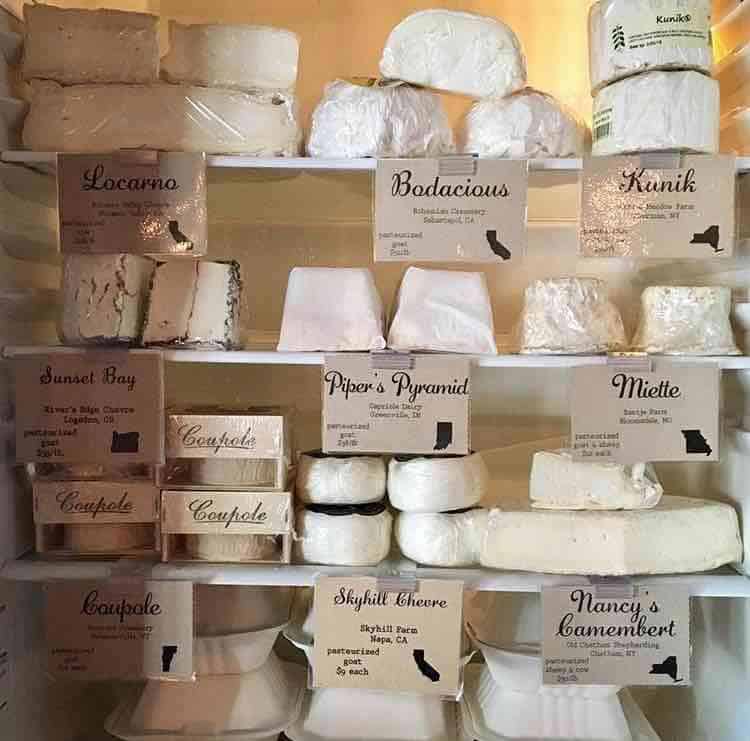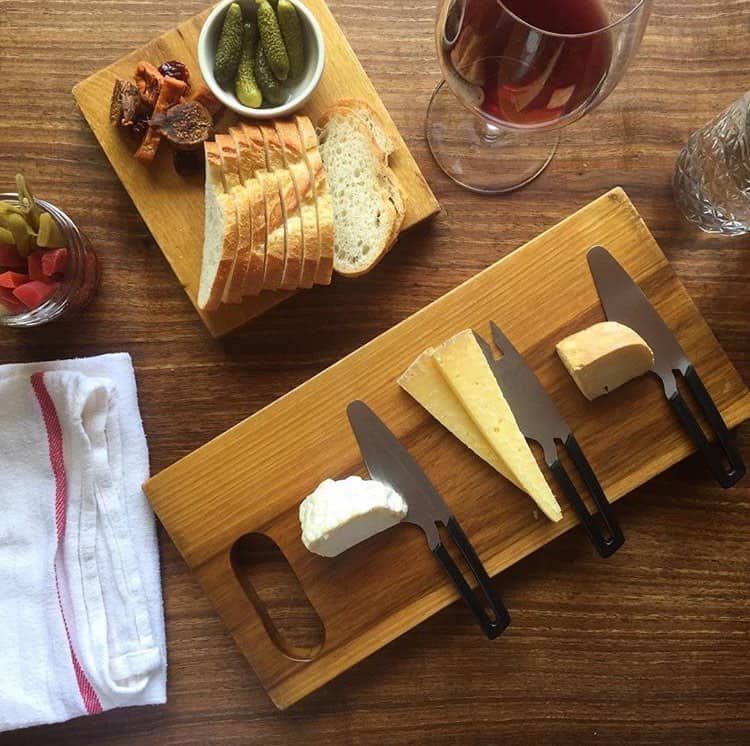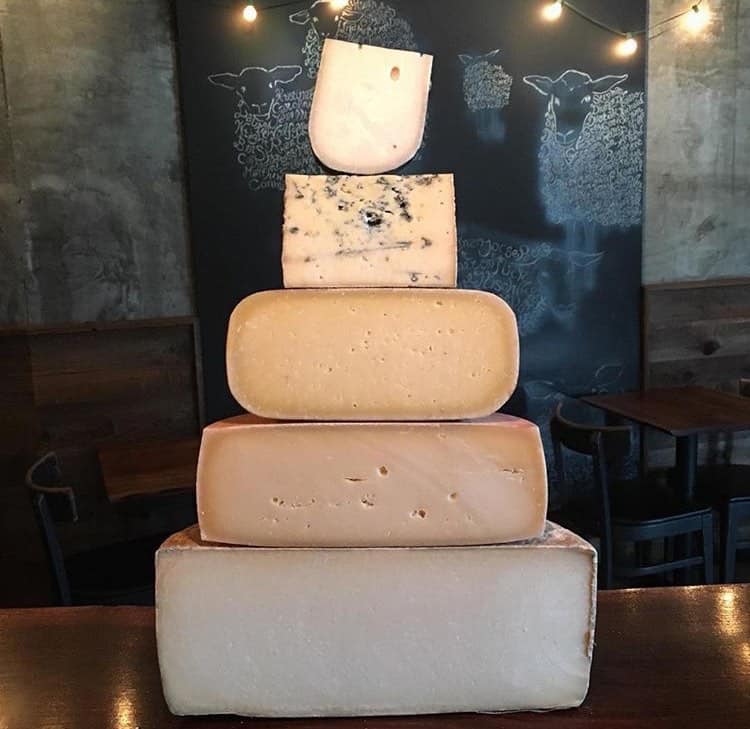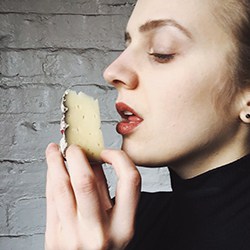
Tucked into the heart of one of San Francisco’s trendiest neighborhoods, Mission Cheese is equal parts cheese bar, retail shop, and swanky restaurant. A champion for the American artisan cheese movement, the shop not only almost exclusively carries domestic cheeses, but owner Sara Dvorak also serves on the Board of Directors for California Artisan Cheese Guild. The shop’s counter is usually stocked with between 45-60 cheeses, allowing them to rotate and showcase a wide range of cheeses.
Since it opened in 2011, the cheese shop has received critical acclaim for its unique cheese experience that features a variety of cheese flights in an unconventional setup: Customers can sit at the bar and engage with the cheesemonger as their flights are prepared.
We sat down with Alex Armstrong, cheesemonger and Director of Events and Education, to learn a little bit more about what makes the shop so special.

Alex Armstrong,cheesemonger and Director of Events and Education at Mission Cheese
culture: What you think sets Mission Cheese apart from other cheese shops?
Alex Armstrong: I’d say it’s definitely two things. First, we are mostly committed to handmade American cheeses. So, we don’t deal with any international cheeses; that’s a deliberate choice. But we also have curated flights and more of a bar experience versus strict retail. We still do retail, but we are, I would say, first, a cheese bar.
culture: I have only come in for the bar, so what is it like to go and actually have the retail experience?
AA: It’s a little bit different: It’s not quite as intuitive because our shop does look more like a bar. Our customers can’t really pick up and look at the cheeses or really access the cheeses except through us. They have to trust us more than I think people are used to.
culture: How do you gain a customer’s trust as a cheesemonger and do you walk them through that experience?
AA: We have to ask a lot of qualifying questions. You have to engage them: Let them taste the cheeses and just have a conversation. If someone is looking for a style, you can, at least, match what they’re asking or find out more with qualifying questions. Say, for example, someone comes in asking for Manchego. I can’t sell them Manchego because we don’t carry it, but I have similar cheeses that are different in a way that they might like because they’re still in that same family.

culture: I like how you guys gain that trust, and you don’t let them feel overwhelmed with knowledge.
AA: It’s more about a dialogue, where you test the waters and ask the basic questions. Some people like to know that the person behind the counter is an expert. Then you have to do it in a way that doesn’t make you sound pretentious—that’s the biggest thing for me. You don’t wanna make someone feel like a dope for not knowing what “lactic set” means or what tyrosine is. Of course people don’t know that.
culture: Can you talk to me a little bit about how you approach building a cheese flight?
AA: We do flights in two different ways. Our regional flights are always composed of cheeses from a specific region. We always have the California flight and then we’ll usually have the midwest flight and an eastern flight. We’ve swapped it around, though. We’ve done a southern flight, a Pacific Northwest flight, Rocky Mountain flight, and a Funky Town USA flight.
The first cheese is always going to be a fresh, soft cheese on the milder side, depending on the customer’s preference or what’s available. The second is always a firmer cheese or maybe a funkier cheese, depending on how the flight’s going. The last cheese is going to be a blue cheese or washed rind cheese category, something that’s going to be bold and robust or pushing the envelope. That will give you a rounded flight.
culture: What cheese is the most interesting to you right now? What are you obsessed with?
AA: A cheese that I’m really pumped about right now is called Death & Taxes. It’s from Bleating Heart Dairy out of Tomales, California. It’s washed in a beer called Death & Taxes, which is a darker ale that gives it a really nice, robust rind. We got batches over the winter, and they were aesthetically perfect, and the flavor was just so well rounded. It was just like ham pudding, which sounds ridiculous. It paired really well with a stout or a porter.
Another cheese is Estero Gold Reserve. That’s the 15-month-old raw cow’s milk cheese from Valley Ford Cheese Company. When you get a batch aged past the 15-month mark, something happens. It’s still very grassy and pineapple-y towards the center, like if you bit into pineapple and it still had some rind on it. Then it goes right into brown butter peanut brittle. It’s a really delicious cheese and every time I try it it’s even better.

culture: What are the weirdest pairings you’ve served that have worked?
AA: People don’t really think IPAs go with cheese, but I think IPAs can crush it if you have the right style that can hold up to the hop character. I once had a pairing with a triple IPA from Altamont Beer Works that was really robust, heavier on the body feel and high alcohol. It was about 10% or so, but when you drank it you got this very nice grassy, earthy, bright, fruity, tropical, pineapple-y note–almost guava or peach. We had a batch of Mt Tam that was particularly ripe, super gooey in the center and really buttery. When we tried it, it legitimately became a Piña Colada in the mouth. The tropical note blasted through the cream layer, and cut all the intense, malty, viscous character. The booziness cut all that fat, so it was cleansing at the same time.
There’s also a red rice distilled sake from Japan that has a weird savoriness to it, like a weird ham-y quality. We tried it with a cheese called Schloss, which is a washed-rind triple cream. It’s super nutty, super creamy, and robust in the center with a hammier finish, so together it just became like al pastor. Boom. Super Rich. Sake and cheese is two different cultures duking it out to see what happens and there’s a lot of cool elements to sake. It has a whole savory side it. It can transfer what a wine can’t.
culture: What cheese question do you get asked the most?
AA: The most often would be: Can you eat the rind? Not a lot of people know what the rind is. The rind is many things, depending on the cheese style, but it’s always still a part of the cheese. We’re always handing out samples, and sometimes people go right to the rind and eat just a teeny bit of the rind itself. That’s great, do it, but you’re probably not going to like it as much unless you eat it with equal parts of the cheese or more cheese. That’s like eating just the skins off an apple and being like, “Yeah, I guess that is pretty edible.” But it’s not as good as if you just crunch a big chunk of apple and you get tannins from the skin, juicy and sweet, and a little tartness. I always try to tell people to eat the rind and eat it with cheese. Some rinds can be pretty intense.
Photo Credit Mission Cheese




